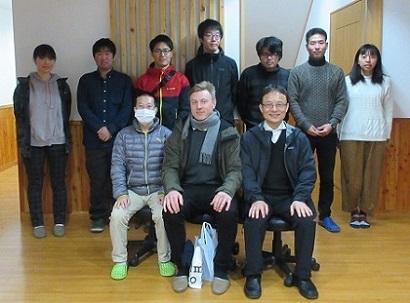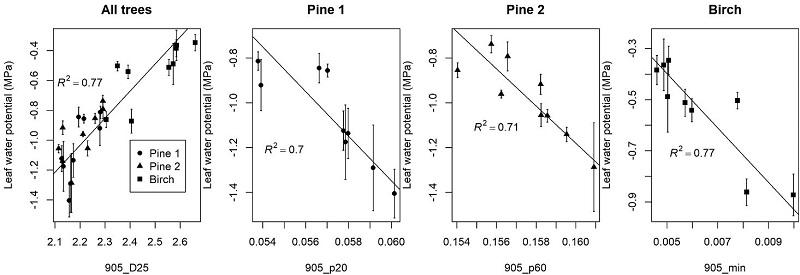A paper that is the product of an international collaboration in the fields of environmental science and remote sensing between Professor Masato Katoh of ICCER, Institute for Mountain Science and specially appointed professor Samuli Junttila was published in the journal "Remote Sensing of Environment". The results of the study will be applied towards the realization of smart precision forestry through laser sensing in the future.
◆ Journal
Remote Sensing of Environment is an international journal of theory, science, applications, and sensing technology of remote sensing research. The Impact Factor is 9.085 and the Cite Score is 15.1, and the journal ranking (Journal Citation Reports) is 7th place / 265 journals in the field of environmental science and 2/30 in the field of remote sensing.
◆ Paper Title
"Terrestrial laser scanning intensity captures diurnal variation in leaf water potential"
◆ Author
Samuli Junttila, T. Holtta, E. Puttonen, M. Katoh, M. Vastaranta, H. Kaartinen, M. Holopainen, H. Hyyppa
◆ Research background
A detailed three-dimensional analysis and forest dynamics analysis of mountainous terrain by state-of-the-art laser sensing for a one month period began on February 9th, 2020 and completed March 8th, 2020 by Dr. Samli Junttila (Faculty of Forest Resources, University of Helsinki), a unit specially invited professor with Professor Hyyppa, a world authority in the field conducted international joint research on the health of forests and the water potential of foliage by laser-sensing.


Photo1. State-of-the-art laser sensing seminar Photo 2. Group photo with Doctor Junttila
◆ Research method
The group developed a non-destructive plant mortality measurement method using laser sensing to obtain information on the widespread moisture status of forests. Over the past few decades, plant mortality has increased worldwide due to droughts caused by extreme weather and global warming. Timely information on plant-water dynamics is essential for understanding and predicting drought plant mortality. The water potential of leaves, usually collected and measured in a destructive manner, is the most common metric that has been used for decades to measure water stress.
◆ Research results
It was clarified that the rate of fluctuation of the water potential of trees can be estimated from the reflection intensity of the ground laser (Fig. 1). The best predictive TLS intensity variables described 70%, 71%, and 77% fluctuations in water potential of all trees, Pine 1, Pine 2, and Birch, respectively. The strongest predictor was mainly the laser reflection intensity at the 905 nm wavelength. 905_D25 (density variable), 905_p20 and 905_p60 (percentage of difference between maximum and minimum intensity), and 905_min (minimum intensity).

Figure. State-of-the-art laser sensing and the rate of fluctuation of the water potential
The research team is continuing to develop technology for smart precision forestry using laser-sensing. They have developed a technology that can non-destructively diagnose the water potential of trees from ground laser measurement. In the future, laser-sensing will be applied for aircraft and drones to monitor the health diagnosis of trees such as pine wilt and oak wilt.
Remote Sensing of Environment is an international journal of theory, science, applications, and sensing technology of remote sensing research. The Impact Factor is 9.085 and the Cite Score is 15.1, and the journal ranking (Journal Citation Reports) is 7th place / 265 journals in the field of environmental science and 2/30 in the field of remote sensing.
◆ Paper Title
"Terrestrial laser scanning intensity captures diurnal variation in leaf water potential"
◆ Author
Samuli Junttila, T. Holtta, E. Puttonen, M. Katoh, M. Vastaranta, H. Kaartinen, M. Holopainen, H. Hyyppa
◆ Research background
A detailed three-dimensional analysis and forest dynamics analysis of mountainous terrain by state-of-the-art laser sensing for a one month period began on February 9th, 2020 and completed March 8th, 2020 by Dr. Samli Junttila (Faculty of Forest Resources, University of Helsinki), a unit specially invited professor with Professor Hyyppa, a world authority in the field conducted international joint research on the health of forests and the water potential of foliage by laser-sensing.


Photo1. State-of-the-art laser sensing seminar Photo 2. Group photo with Doctor Junttila
◆ Research method
The group developed a non-destructive plant mortality measurement method using laser sensing to obtain information on the widespread moisture status of forests. Over the past few decades, plant mortality has increased worldwide due to droughts caused by extreme weather and global warming. Timely information on plant-water dynamics is essential for understanding and predicting drought plant mortality. The water potential of leaves, usually collected and measured in a destructive manner, is the most common metric that has been used for decades to measure water stress.
◆ Research results
It was clarified that the rate of fluctuation of the water potential of trees can be estimated from the reflection intensity of the ground laser (Fig. 1). The best predictive TLS intensity variables described 70%, 71%, and 77% fluctuations in water potential of all trees, Pine 1, Pine 2, and Birch, respectively. The strongest predictor was mainly the laser reflection intensity at the 905 nm wavelength. 905_D25 (density variable), 905_p20 and 905_p60 (percentage of difference between maximum and minimum intensity), and 905_min (minimum intensity).

Figure. State-of-the-art laser sensing and the rate of fluctuation of the water potential
The research team is continuing to develop technology for smart precision forestry using laser-sensing. They have developed a technology that can non-destructively diagnose the water potential of trees from ground laser measurement. In the future, laser-sensing will be applied for aircraft and drones to monitor the health diagnosis of trees such as pine wilt and oak wilt.

